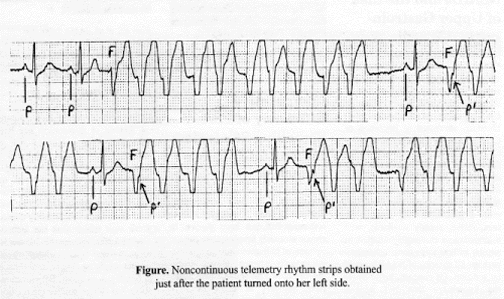ECG Review-VT on Recumbency?
ECG Review-VT on Recumbency?

Clinical Scenario: The telemetry rhythm strips shown here were obtained from a patient with a long history of alcohol abuse. Serum potassium and magnesium levels were both below normal. Runs of tachycardia similar to those shown seemed to occur each time the patient turned over on her left side. Do the runs of wide-complex tachycardia (WCT) represent ventricular tachycardia (VT)? How certain are you of your answer? Is it likely to be coincidence (or a product of the telemetry nurse’s imagination) that left-sided recumbency seemed to precipitate this arrhythmia? How would you treat the rhythm?
Interpretation: Despite the paucity of narrow complexes, the underlying rhythm is sinus, as evidenced by the presence of two consecutive sinus-conducted beats at the beginning of the top rhythm strip (upright P wave, constant PR interval). Periodic isolated sinus beats punctuate both tracings. The runs of WCT are clearly VT. We say this because: 1) QRS morphology looks like VT (the QRS is wide and very different from sinus-conducted beats); 2) there is evidence of AV dissociation (despite the onset of WCT, the next sinus P wave occurs right on time at the beginning of several WCT runs, seen as a notch [P’] in the S wave of the first VT beat); 3) there is a fusion beat (F) at the onset of each run; 4) there are post-ectopic pauses after each run, which are followed by sinus capture beats; and 5) VT is by far the most common cause of WCT (and there is no reason at all in this case to suspect aberrant conduction). The runs of VT seen here are slightly irregular, which can occur with this arrhythmia.
Although the mechanism is unclear, position changes (most commonly assumption of the left lateral decubitus position) probably do precipitate VT in an occasional patient with ventricular irritability who is predisposed to ventricular ectopy (Grauer K, et al. Fam Prac Recert 1990;12:32-46). We, therefore, would believe the nurse’s observation and avoid the left lateral decubitus position, at least until serum electrolytes were corrected.
Subscribe Now for Access
You have reached your article limit for the month. We hope you found our articles both enjoyable and insightful. For information on new subscriptions, product trials, alternative billing arrangements or group and site discounts please call 800-688-2421. We look forward to having you as a long-term member of the Relias Media community.
